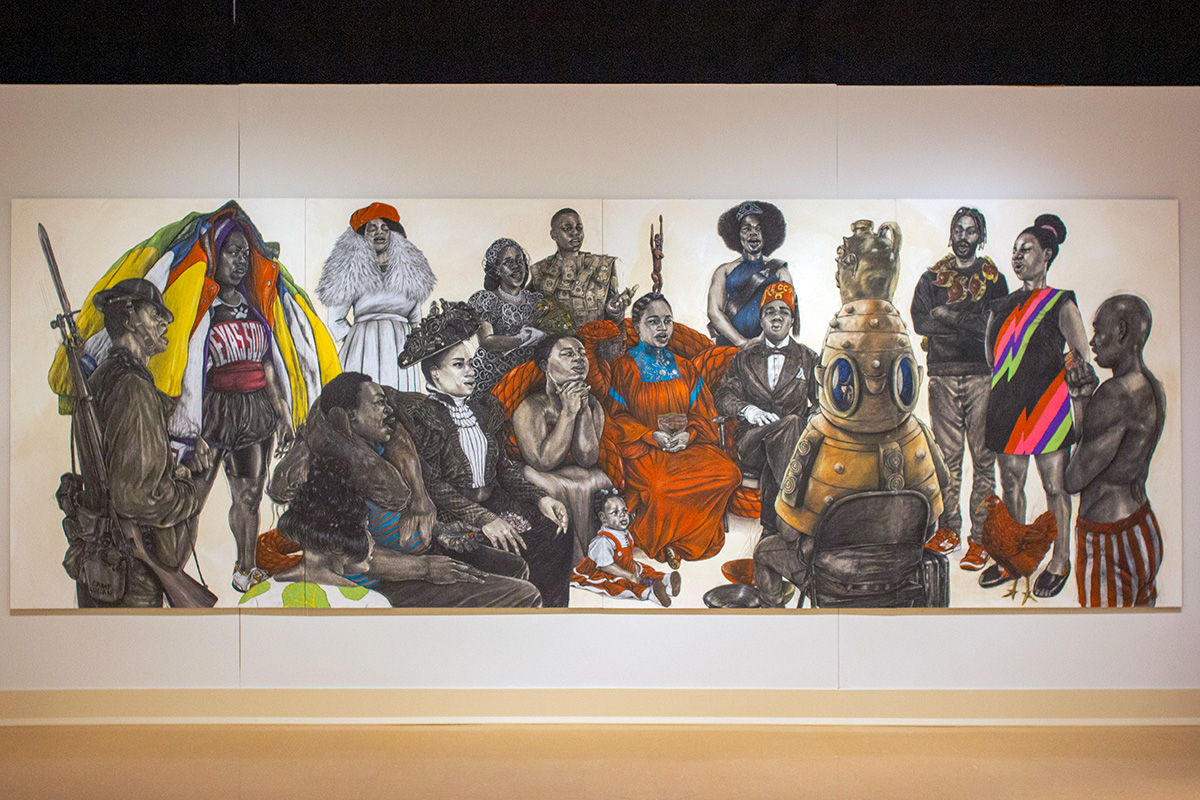After listening to the sounds of the Black Monks as part of Theaster Gates Jr.’s sculptural installation “The Double Wide” at the Mississippi Museum of Art, I mosey over to the group of people gathered around its neighbor. A guide is engaging patrons in a discussion about Jamea Richmond-Edwards’ “The Water Runs Deep.”
The three-panel painting depicts Richmond-Edwards’ family riding a sea serpent across the ocean. The piece is captivating and bright, due to the fluorescent colors that the artist uses across the scene: bright blue for the ocean, bright pink for the sky, gold, green, yellow, brown and purple. The eyes don’t know where to look first.
“When I started doing my family’s genealogy, I kept running into water. My family was affected by the flooding of the Mississippi River throughout Arkansas and Mississippi,” she told the audience at the opening of “A Movement In Every Direction” on April 9.
“And then my family moved to St. Louis because of the floods, and it was like the 1927 tornadoes as soon as they landed.“We hear of these conversations about migration and, historically, I never really considered the role the climate played in it.”
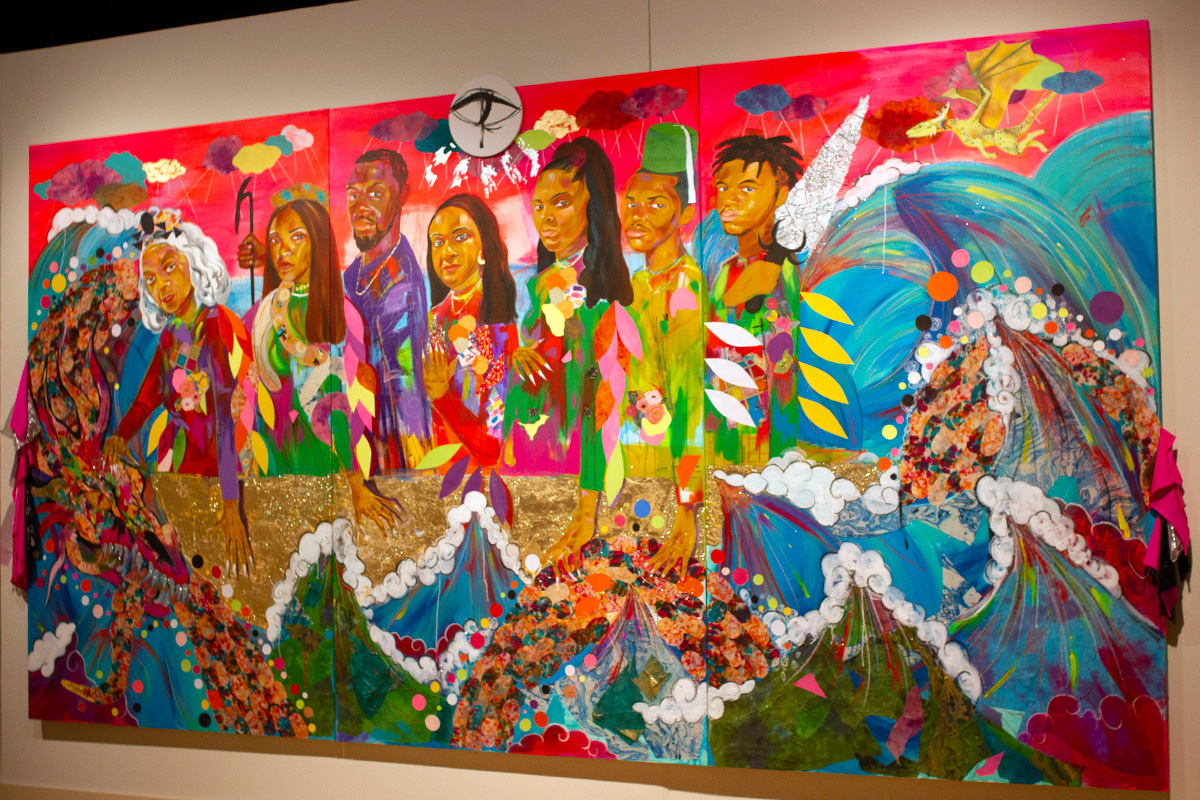
The artist said she has an overwhelming fear of water, despite the fact that she can swim. Discovering that the planet and the human body is 70% water, Richmond-Edwards realized she couldn’t fear something that she is.
“I am water. Looking at the water as this analogy for my family’s story, all the adversity they faced, but the figures on this boat are unmoved by it. So, here we are on this golden boat, surrounded by something that is considered this monstrous, evil creature that is in a sense protecting us,” she explained.
Standing on that golden boat are versions of Jamea’s mother, herself, her husband, her sisters and her sons. Each is personalized in their own way, showing how intimately she knows each family member. One of her sisters holds lightning in her hand, a reference to when lightning hit her as a teen. Her husband is holding a scepter in his hand, the Egyptian symbolism for a healer. He’s an acupuncturist.
Her mother is wearing a headpiece as the matriarch and leader of the family. One of her sons is holding a carillon, a weapon from the Japanese anime WorldEnd, a reference to his love of anime. All the women on the boat are sporting acrylic nails, an ode to their hometown of Detroit, the hair and nail capitol.
“This painting really became a love story to my family. I just wanted to make sure it was made in the same way I view them. Not the template of history that’s assigned to us,” Richmond-Edwards explained.
‘To Mississippi, To Los Angeles, To South Florida’
Jamea Richmond-Edwards is one of 12 artists featured in “A Movement In Every Direction: Legacies of the Great Migration,” where Black artists explore their familial connections to the Great Migration through painting, film, audio and sculpture. The new exhibit had its opening day at the Mississippi Museum of Art on Saturday, April 9, 2022, with panels and an exploration of the exhibit, free of charge.
The Great Migration was the migration of more than 6 million African Americans from the rural South to cities in the North, Midwest and West from 1916 to 1970 to escape brutal Jim Crow segregation and race violence and to seek new opportunities.
Jessica Bell Brown and Ryan N. Dennis were the curators of “A Movement in Every Direction.” Dennis joined the Mississippi Museum of Art in 2020, while Brown became a member of the Baltimore Museum of Art in 2019. The exhibit started as an idea from the Mississippi Museum of Art, but the duo expanded on the idea and started researching the artists they wanted to collaborate with.
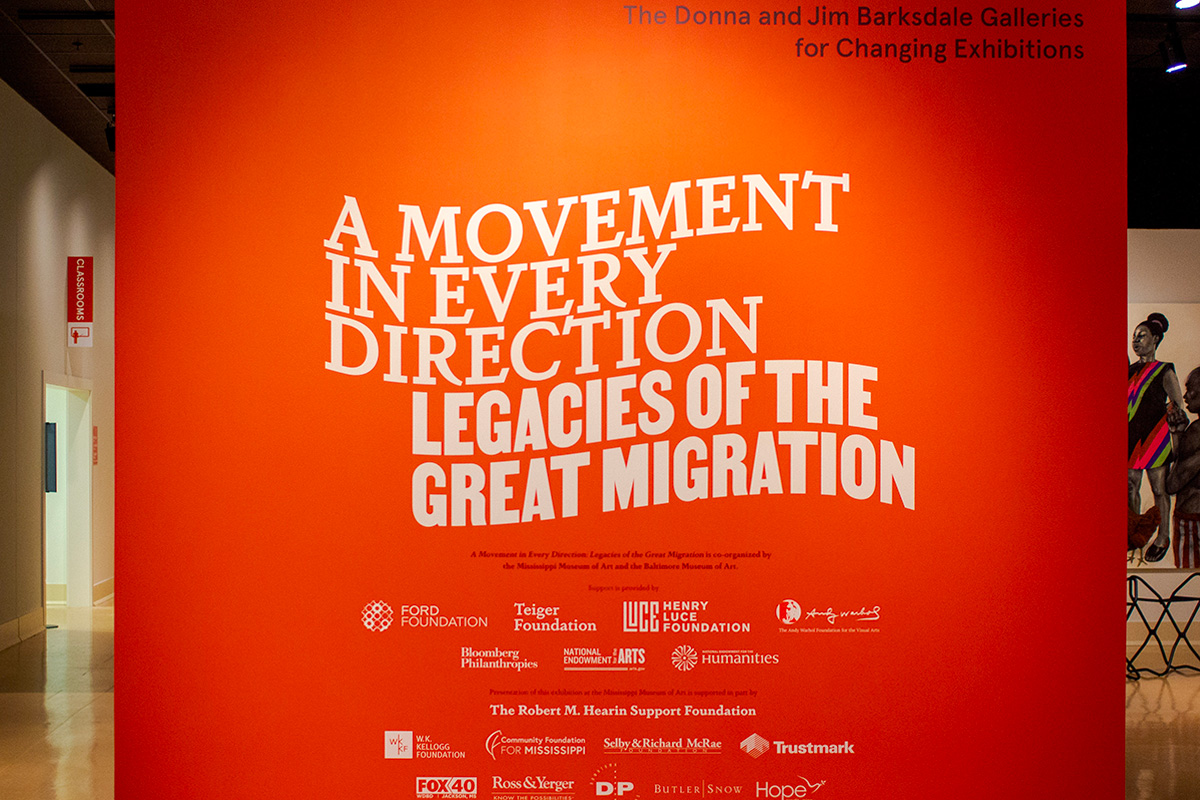
“We asked ourselves early on: What hasn’t been said about the Great Migration, and how do we use that as a starting place? Are there certain givens about the Great Migration that we could pick apart?” Brown said in an interview with the museum’s Education Team provided at the opening.
“So much of this exhibition has developed by following the lead of artists and expanding that outward,” Dennis said in the interview. He said the exhibition allows the audience to see people and artists in various ways and connect to a historical moment while also showing that the migration isn’t stopping.
“This show is taking us to Alabama; is taking us to North and South Carolina; is taking us to the South Side of Chicago and Detroit; is taking us to Blackdom, New Mexico; to Mississippi; to Los Angeles,” Brown said.
“It’s taking us to South Florida, and Kentucky, and Tennessee. It’s taking us to Okinawa, to Vietnam. It’s taking us everywhere. It’s spanning histories, but always connecting to the present.”
The show complicates a straightforward or linear understanding of a place in time and offers a beautiful way to think about how people experience time, place and each other in interconnected ways, Brown continued.
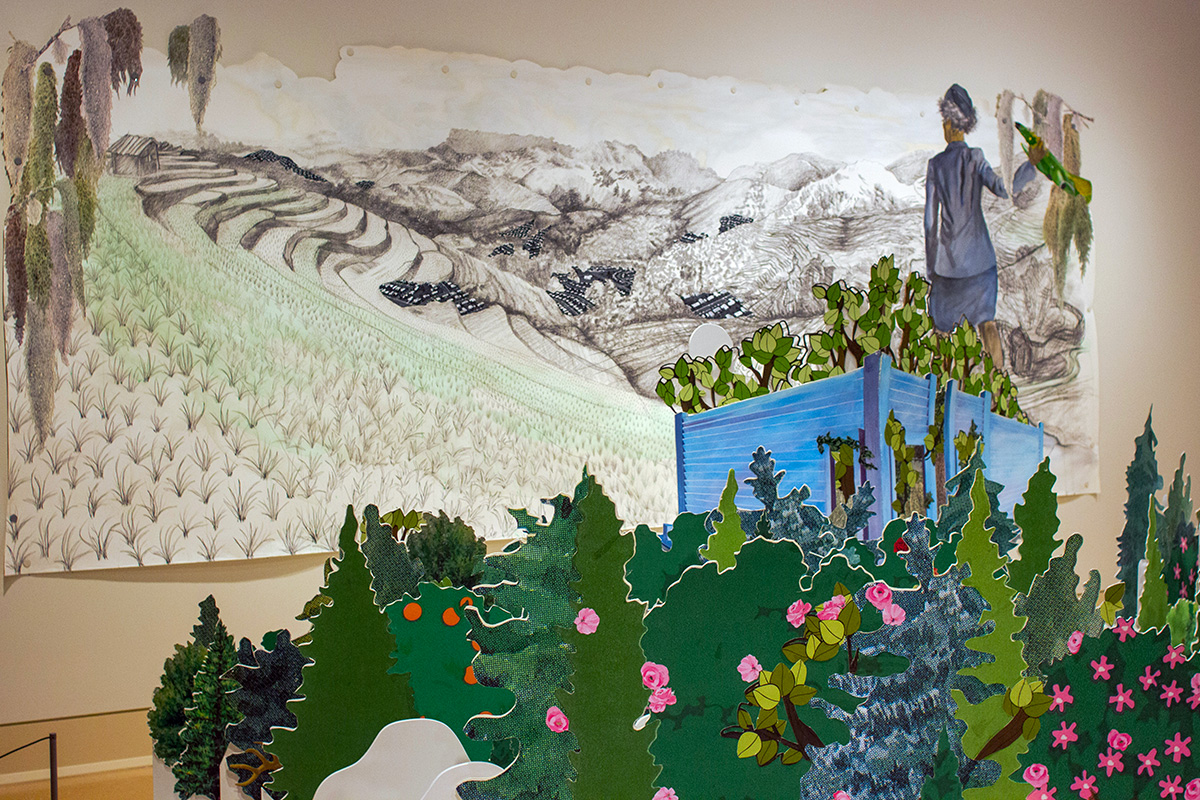
“My hope is that the show invites people to investigate where their families’ histories are within this time period and to this day. My hope is that people will have more inquiries into family relics, photographs and archives,” Dennis said.
Dennis has family, on both sides, from Louisiana, Texas and parts of Alabama. Though most of her family stayed in the South, the few who did leave went to California during the second wave of the migration. Brown said most of her family stayed in the South, though she has a few distant cousins in Detroit, Ohio and Texas.
“When you know more about your people, you begin to know more about yourself, you stand a little taller,” Dennis added.
‘Miracle and Beauty of the Black Ordinary’
Every summer, the Mississippi Museum of Art works with family reunion groups from the north who want to trace their family lineage in Mississippi. They research their stories using the museum archives, a tool that was most helpful for the artists participating in the exhibition.
“I think as a scholar, there are these protocols of approaching an archive, and so many of those protocols are dictated by disciplinary practices, which wind up reducing hierarchies and knowledge of life, which makes certain kinds of questions impossible to think, Sadiya Hartman said during the “Memory and Ancestry Within and Without the Archives” panel.
But artists have taught Hartman that the archive is material, that it has elasticity, she said. The scholar said she searched the archives searching for the miracle and beauty of the Black ordinary.
“It was a sense of really wanting to attend to the practices of ordinary Black folks and really thinking about everything that is required to survive, to sustain yourself and try to thrive in these really brutal circumstances.”
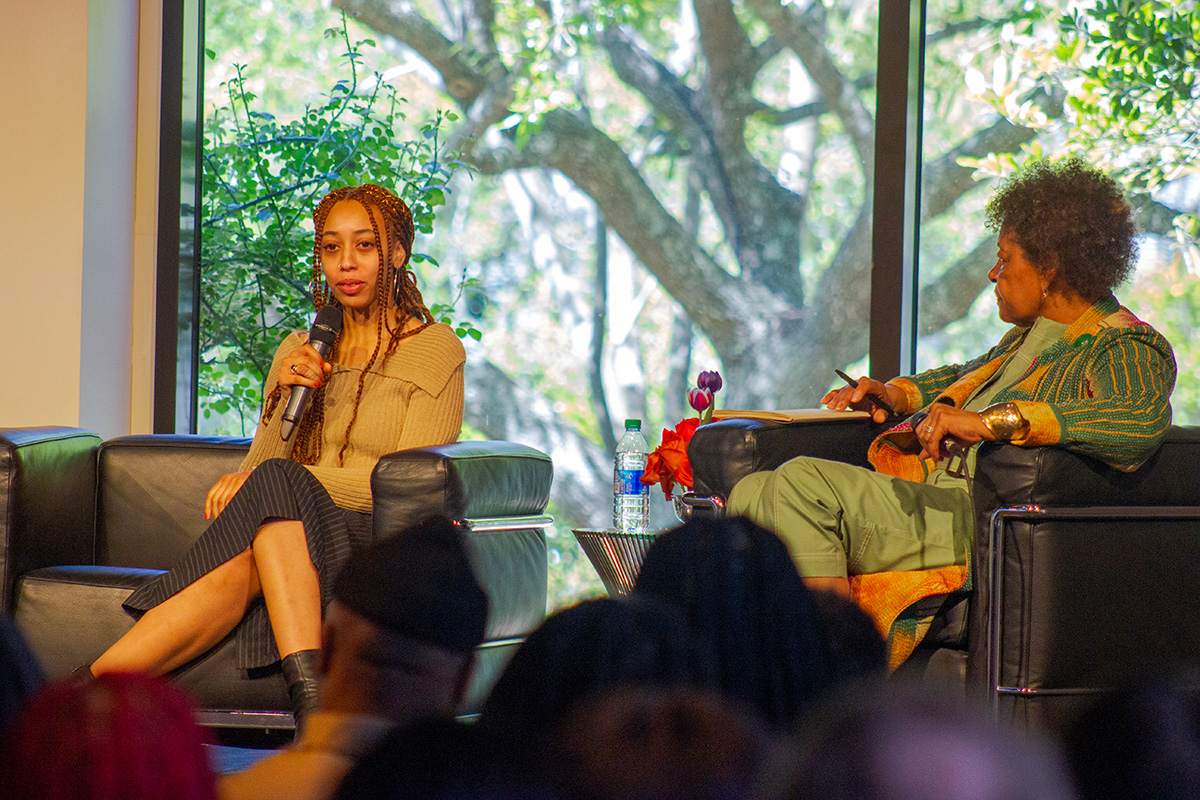
Artist Akea Brionne said working with the archive was an emotional and spiritual journey that at the same time is also incredibly taxing. Brionne, the youngest and only descendant left on her grandfather’s side, started to construct her family archive in an effort to preserve its legacy.
“To really embark on that consistently in a way that consumes how you move your body to travel to what landscapes you’re taking in, how you’re thinking about those landscapes and who was moving through these spaces, whose feet were touching the soil. It’s something that encompasses every part of my life. It’s a bit of an obsession,” Brionne said during the panel.
Brionne’s piece “An Ode to Y(ou)’all” explores the strength and resilience of her great grandmother and four great aunts, who remained in the South. She took her family’s photos from the 1920s through the 1950s and turned them into Jacquard textiles with hand-sewn embellishments.
The textiles vary in shape and size, though each shape has four sides like a window. The photos are almost washed out and transparent, similar to a mirror or window. In one textile, a couple is sitting outside on a porch, gold embellishments highlighting the house. The couple’s clothes glisten with white, blue and gold rhinestones. The border of the textile is a black ruffle material that acts as a frame.
Brionne calls this piece “Porch Sittin.”
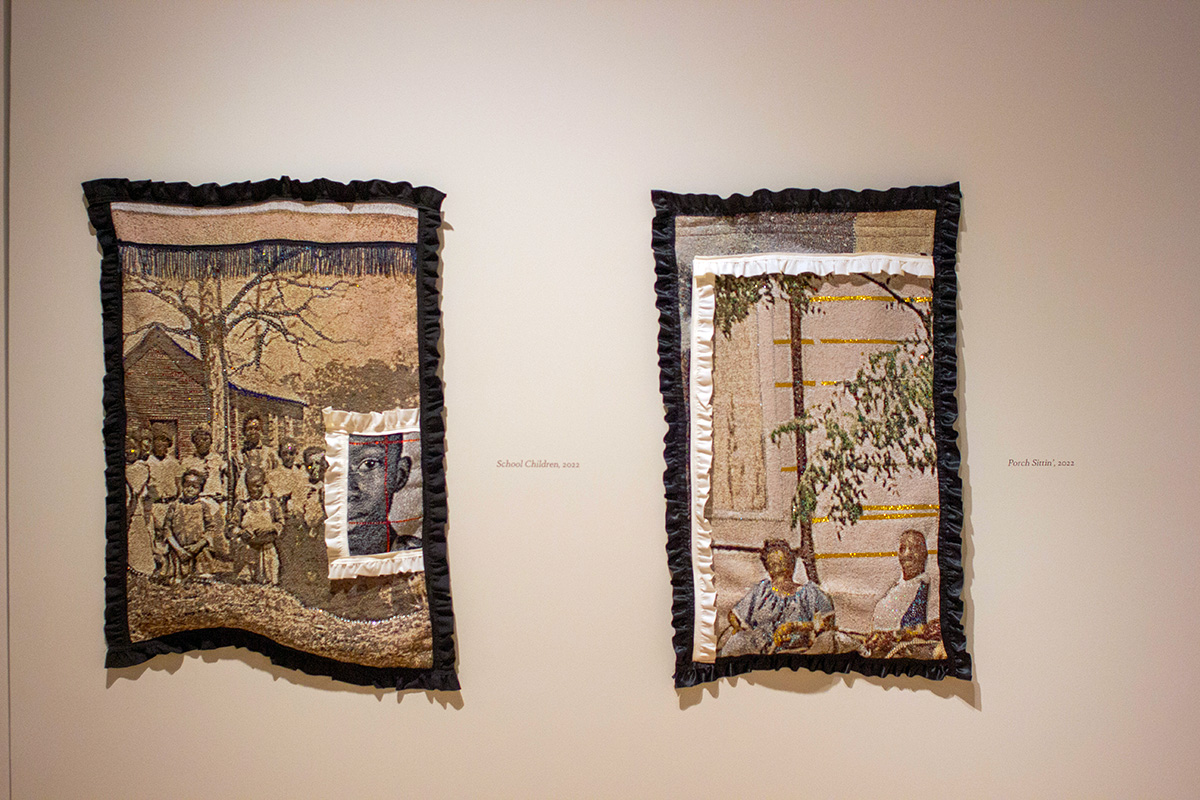
Next to that piece is a photo of children standing outside their school. Within the photo is another smaller photo, framed in white ruffles and showcasing half the face of a Black boy, most likely one of the artist’s ancestors. Three glittery red lines, two vertical and one horizontal, decorate the young boy’s face. This one is titled “School Children.”
The images showcase Brionne’s family’s time in Columbus, Miss., and display moments that are mundane, but no less extraordinary to look at.
Owning Land, Starting The Afro Newspaper
Savannah Woods’ roots run deep. Her family started a Baltimore newspaper, The Afro, in 1892 using $200 from her great-great-grandmother Martha. Questions began to arise around how a Black woman would have $200 in 1982.
While going through some of her family’s possessions, Woods found a box with her great-great-grandmother’s obituary inside with the clearest photo of her ancestor she’d ever seen, Woods recalled. She learned that her great-great-grandmother was enslaved on a farm that her family eventually came to own. Martha’s father became a wealthy landowner.
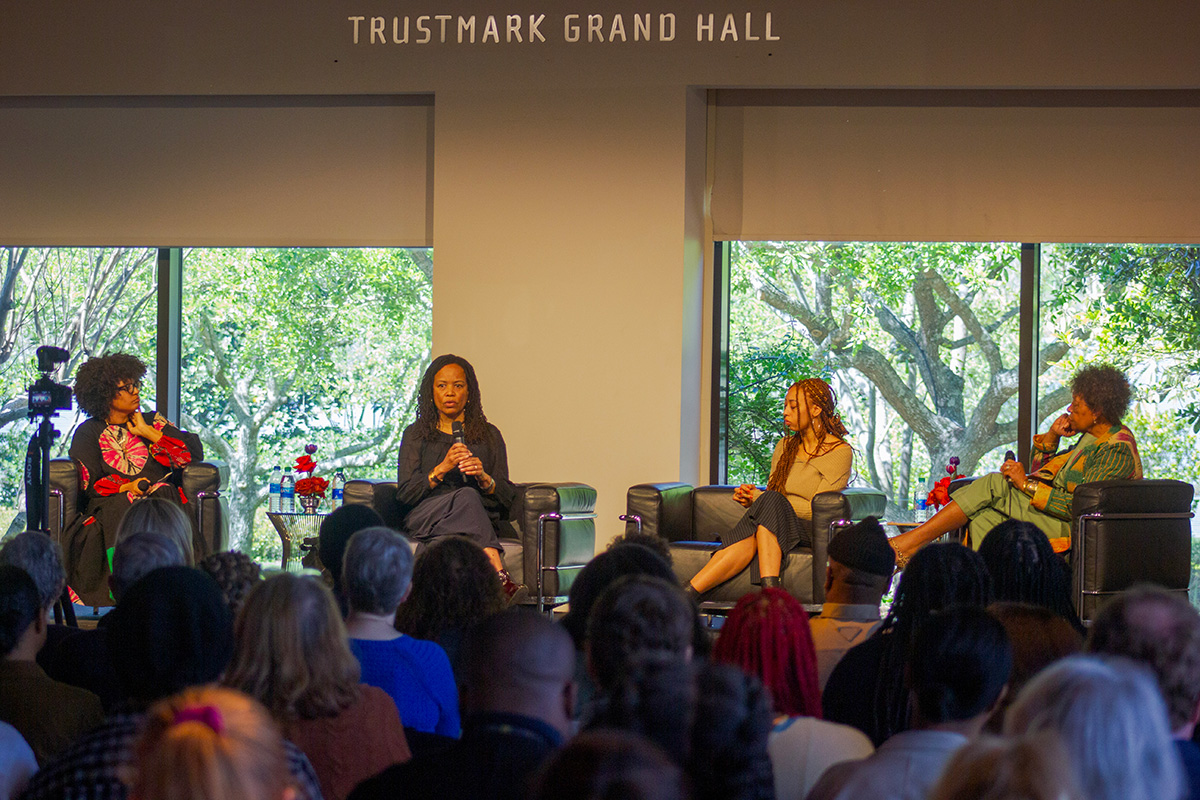
“Through the digging, I learned that it is a myth because what happened actually was that the newspaper existed in 1892, but they purchased it in 1897. How they had the money was that her father died and left her with this land, and then she sold this portion of the land and used that to invest in her husband’s business,” Woods told the audience.
Woods said as she learns more about her family’s history, they keep showing up more clearly to her, and she is meeting new family members along the way.
“I’ll find a new image of her, and it’s the clearest one I’ve seen, yet,” Woods said excitedly.
Unpacking Her Grandfather’s Violent Death
Artist Carrie Mae Weems, whose family has Mississippi roots, was able to find a copy of her grandfather’s World War I draft card, footage, and photos of sharecroppers working in the cotton fields and tools her grandfather might have used in the archives.
“The archive for me then has been a way for me to unpack my own family story, and it’s always been a way to really think about the deeper meaning of what my family itself represents, even if it represents and stands for itself,” the Portland, Ore., native said.
The story and loss of her grandfather, Frank Weems, was an ongoing story that needed to be unpacked, she said. The exhibition gave her the opportunity to understand in the deepest way the notion of reparation and the question surrounding restitution, Weems said.
Her grandfather was a Southern Tenant Farmers’ Union organizer and a sharecropper on the Dibble Plantation in Earle, Ark. After an anti-union eviction, a white mob attacked him, leaving him for dead on June 9, 1936.
But, he escaped and followed the North Star to Chicago, and Weems explores his disappearance in “The North Star.” Against a wall rests seven framed circular photos of the North Star, increasing in size from left to right, with the biggest star in the middle, before the frames descend into smaller sizes.
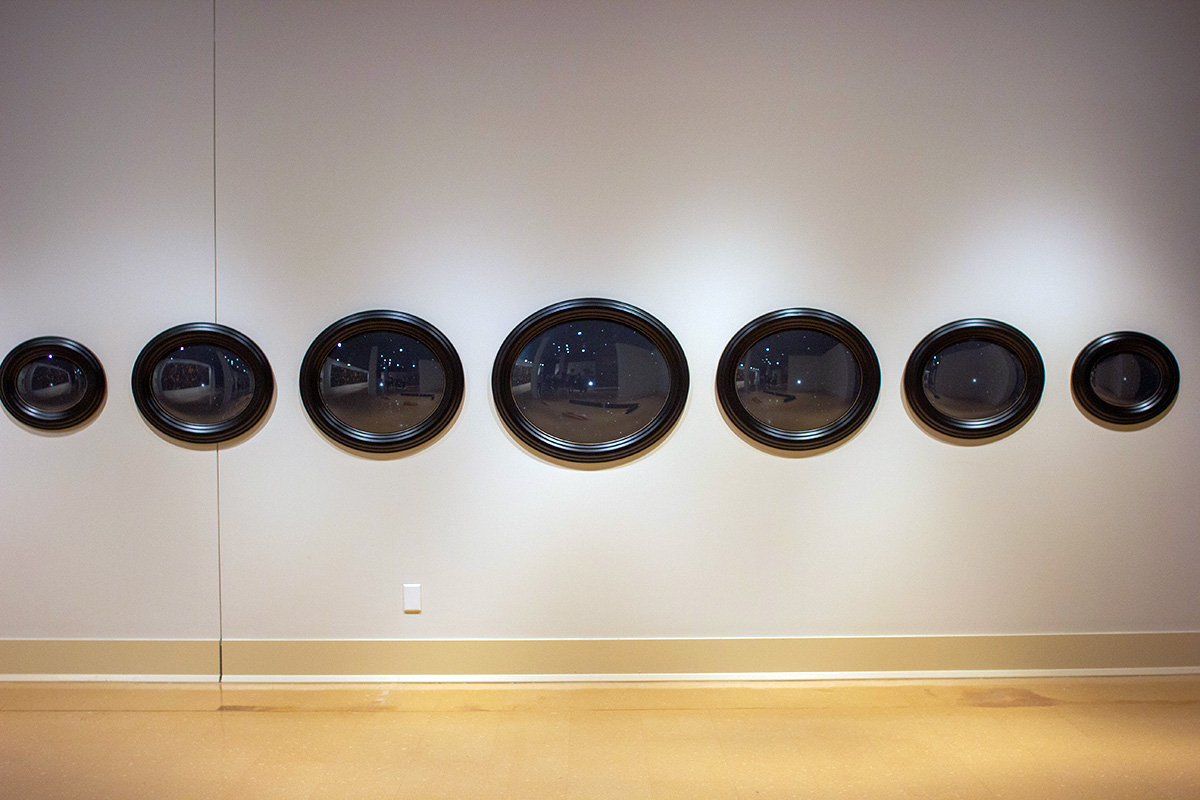
Walking closer to the photos, one can see their reflection, as vivid and clear as a mirror. Next to the stars is “LEAVE, LEAVE NOW!,” a video installation that uses a “Pepper Ghost,” historic illusion, to showcase ghostly figures. The entire room is dark, so dark that you can’t see any figures in the room.
A stage with red curtains is the center of focus as ghost-like figures appear on the glass screen with Carrie Mae Weems narrating. The feeling of walking into the room for the first time is almost disconcerting, not nearly as much as having to forcibly migrate North to escape the evils of racism, leaving behind loved ones.
Weems realized that the work could not stop at researching her grandfather’s story and sharing it with the public. Her grandfather attempted to file suit against the state of Arkansas, but he was not able to, she said.
“And I thought, oh shit. I could sue the State of Arkansas in the name of Frank Weems for his mistreatment and his forced migration, his forced escape. That I could actually sue the State of Arkansas for crimes against humanity. And that is what this exhibition has given to me: the ability and understanding that as an artist I could use this platform in this work to do that,” Weems remarked.
‘Disrupt the Narrative’
When curator Ryan Dennis reached out to Mark Bradford about participating in “A Movement in Every Direction,” he wondered how he would dig into this project. He didn’t have any direct connections to the Great Migration. He didn’t know anything about his father’s side of the family, though his mother had family in Pennsylvania and North Carolina.
Bradford had not visited any of those places, and he grew up in South Central Los Angeles in a boarding home with his mother and other relatives.
“I started thinking about the legacy of the chosen family, play cousins and play brothers and the fragmentation that happens when we do migrate. I kind of went and reached into it that way,” Bradford told the audience at “An Unfinished Movement” panel.
In his approach to this exhibit, Bradford imagined that he and his mom may have wanted to move out of the South, but where they would go was the unanswered question.
He began searching through Crisis magazine, a periodical W.E.B Du Bois started, and looked at the advertisements in the back.
“I read every periodical. I just kept going and kept going, and then that kind of mercantile language was familiar to me,” Bradford explained. Ads, billboards and merchant posters are common in Bradford’s work.
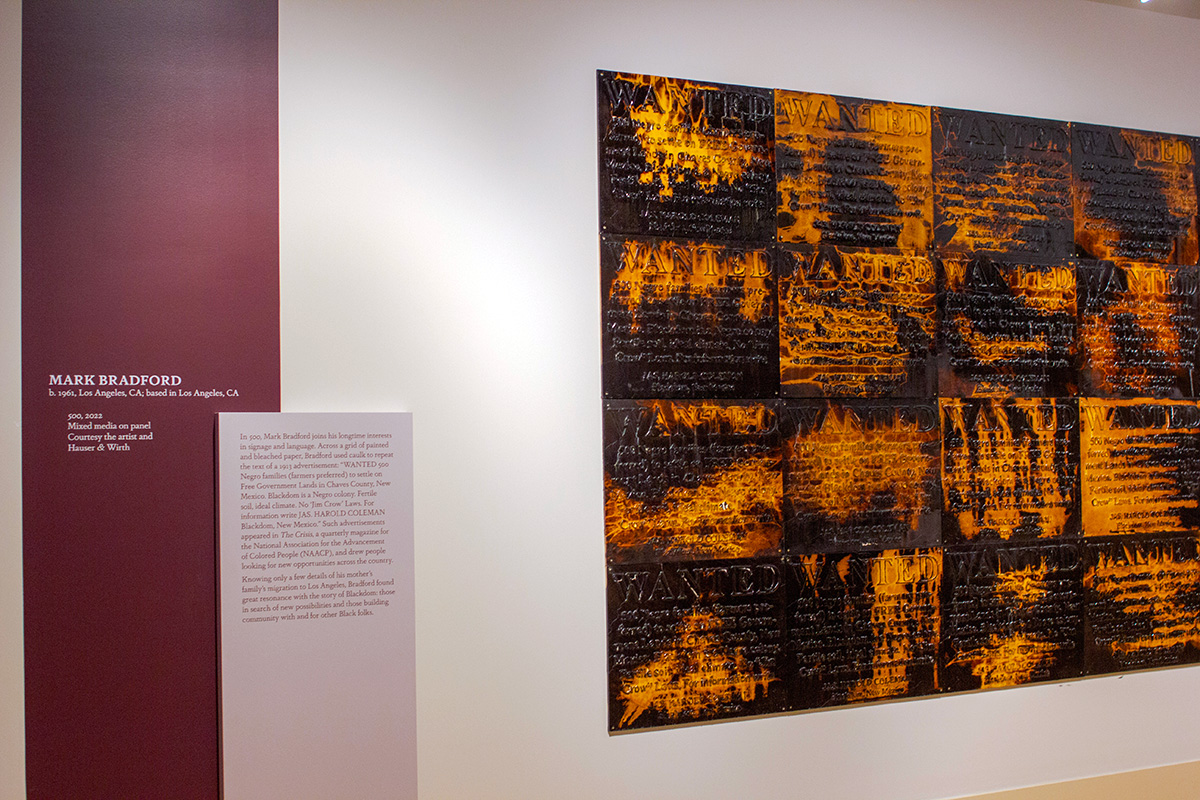
“And then I saw this little advertisement for families that wanted to settle in Blackdom, New Mexico, where there was no Jim Crow laws. I thought you wouldn’t have to tell me twice,” he added.
Thirteen African Americans incorporated Blackdom, N.M., in 1903. The group formed the Blackdom Townsite Company with $10,000 in combined assets, and they named Frank Boyer as their president.
The Boyers, Herrons, Proffits, Collins, Eubanks, Wilsons and Smiths were prominent families in Blackdom, and many of the families were intertwined through kin and marriage. The city’s population was estimated at around 150 people, and at least 12 women were homesteaders. One of those women, Mattie Moore Wilson, owned 640 acres of land under two different land laws.
Many residents lived on farms, but there was also a small village that gained its own post office in 1912. The village established a store, a new church, a pumping plant and an office building. The town also established a community school that ensured Blackdom’s children would be educated because residents understood the importance of education and its connection to power and influence.
This signage Bradford found became “500,” which focuses on the word “wanted” and the desire to attract Black families to New Mexico contrasted against the negative and historical connotations surrounding the word in relation to Black people.
The piece takes up an entire wall in the exhibit in a repetitive pattern. The signage is a burnt orange and black, sporting a burned look. Heat is something Bradford said he has always used in his work, even when he worked at his mother’s hair salon.
“It looks like it’s on fire a little bit. Fire is something we’ve always used for protest, to get attention. Also, fire is a cleansing element. It’s always been a cleansing element. … Something so natural that can possibly tear down a city, also can breathe new life,” Bradford said.
Bradford said normally the text “wanted” is normally seen as policing, but in this installation, he wanted to go the opposite route.
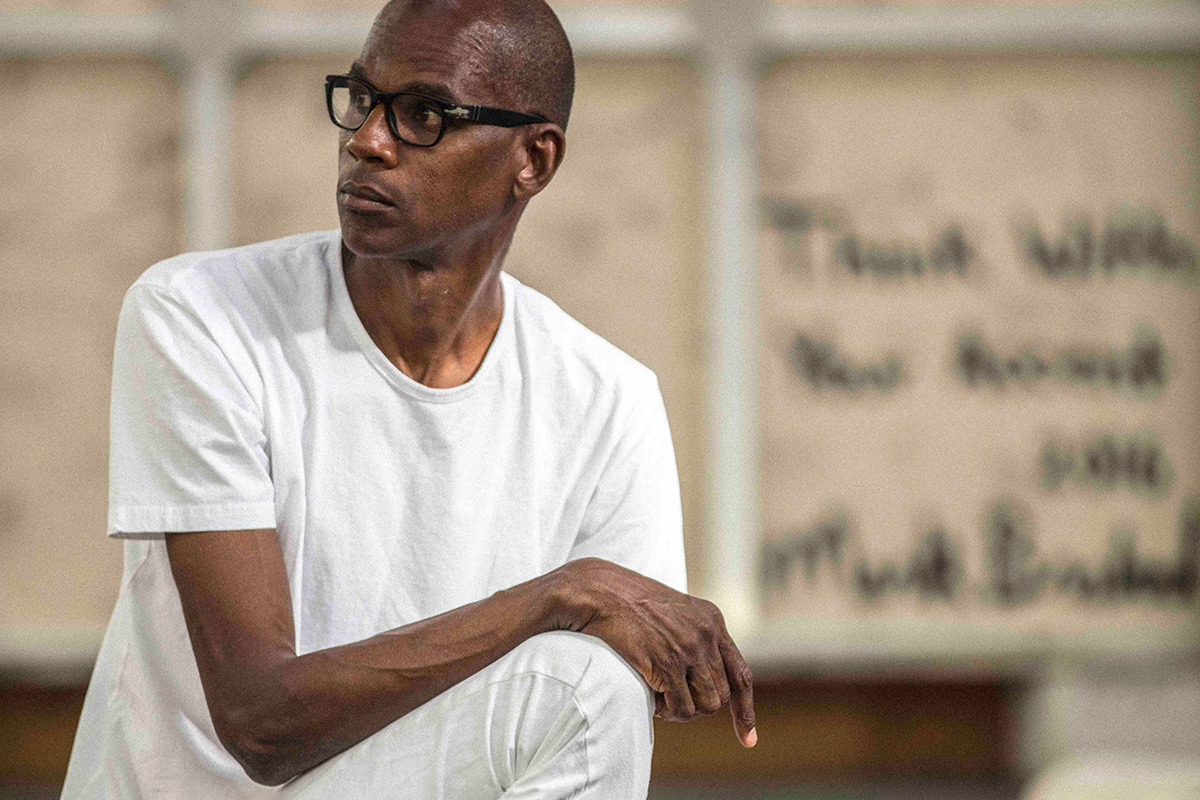
“They were trying to get these Black people’s attention who were reading. They wanted to jump out and say, ‘here’s a possibility.’ I looked at it as a possibility. But then I started looking at it through my gaze and said, ‘wow, it almost reminds me of the slave posters of years ago,’” Bradford said.
The panels repeat themselves horizontally and though the numbers don’t equate to 500 panels, Bradford said he wanted repetition that starts to break down and become something more.
Interestingly, Blackdom wasn’t burned down, but abandoned due to the water drying up. It became a ghost town.
“I’ve always been the type of person that I don’t look away from things that are harsh. I kind of pull them from the social fabric and pull them into my studio and kind of make my own recipe,” the Los Angeles native said.
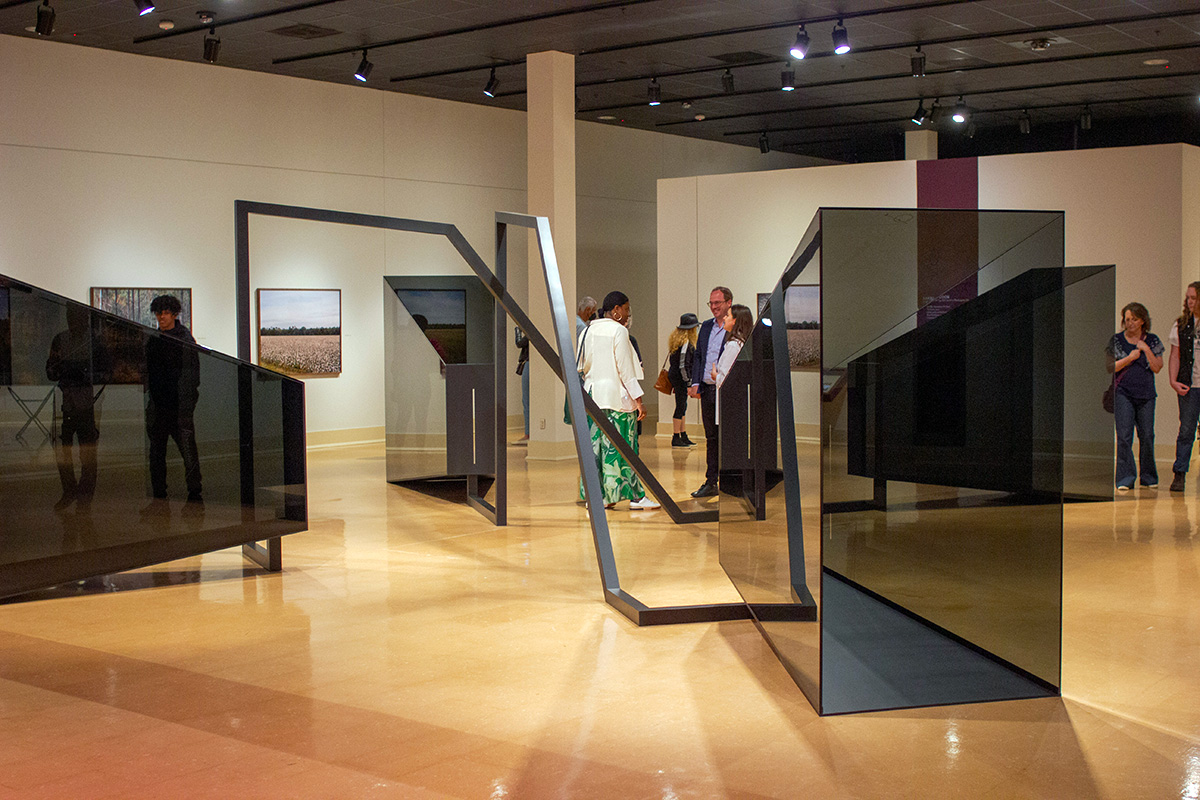
Victoria Johnson, from Memphis, Tenn., asked Darren Walker and Mark Bradford about building connections and being in community with figures like themselves so that southerners do not have to leave to get what they want or need. This narrative is often touted about the South, causing many to leave their familiar settings and culture for places like New York and California.
Ford Foundation President and author Darren Walker said at the opening that as a southerner he was always taught that little boys like him needed to leave the south to be successful, that his dreams were in New York or San Francisco, not his hometown of Crowley, La.
“As the South goes, America goes, regardless of what the people on the coasts think. We have to invest in the South and invest in connecting the South to itself and to the rest of the country and the world,” Walker said.
Black people are increasingly returning to the American South. New York’s last census showed that more African American New Yorkers left the city than came. The kids and grandkids of the original people who moved North are coming back to the South, the Ford Foundation president said.
The narrative needs to change from the South being a place people don’t want to live, but have to live because they can’t leave, he added. “If we can disrupt that narrative, and that has to be the work of all of us in this room, it will go a long way to the South you want to live in,” Walker said.

